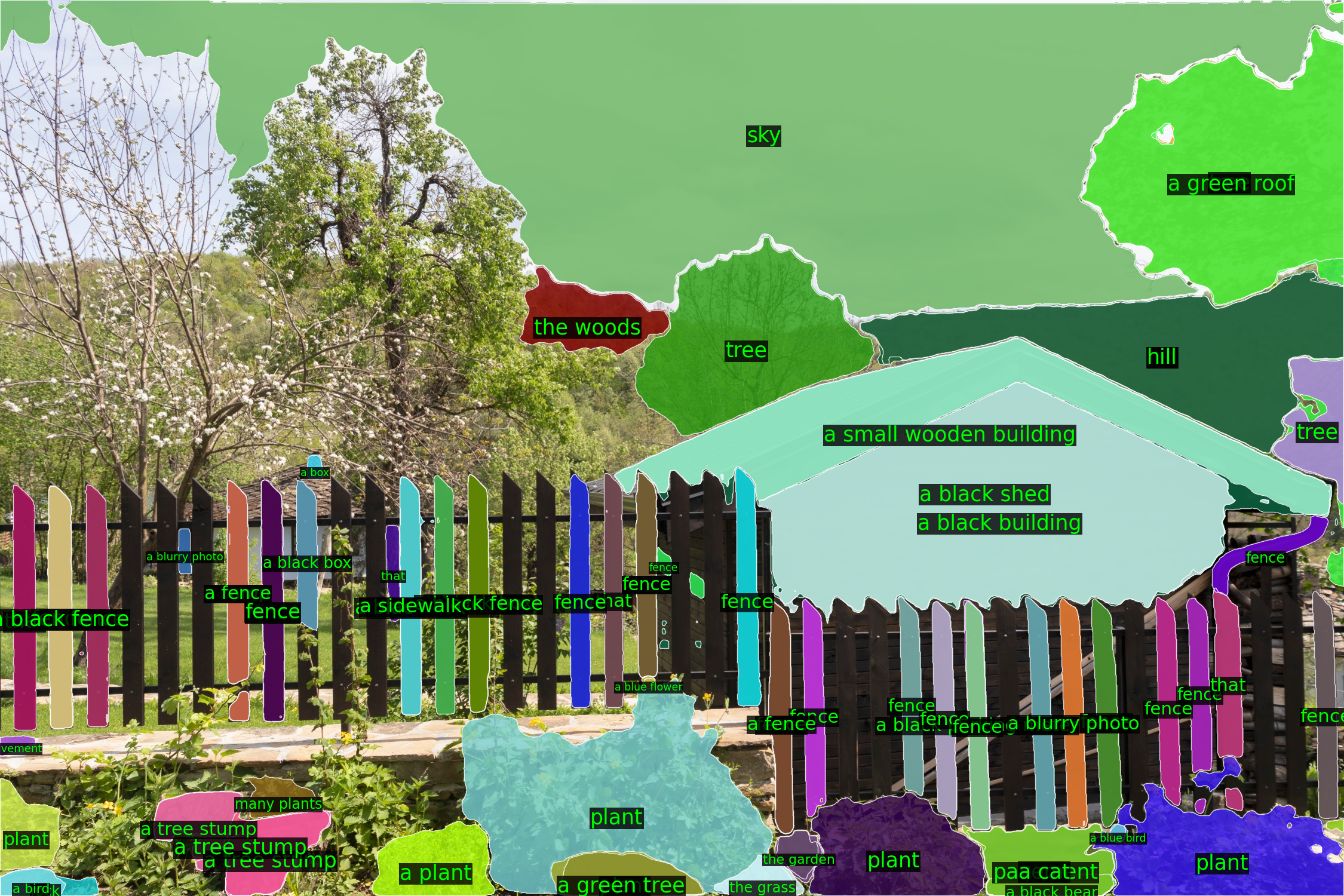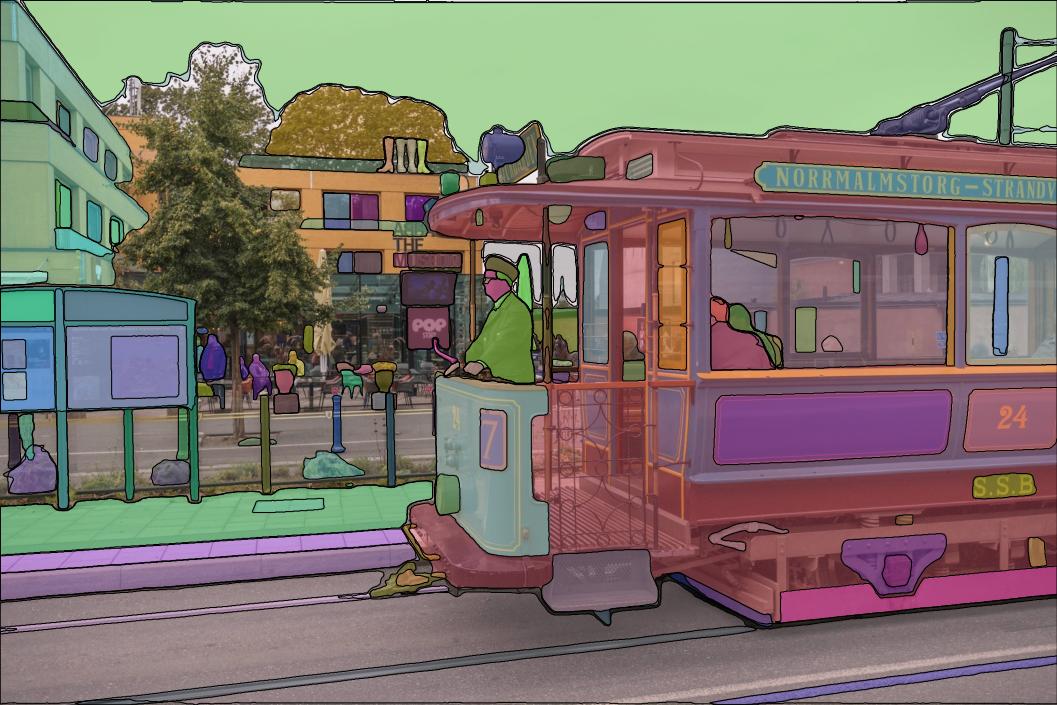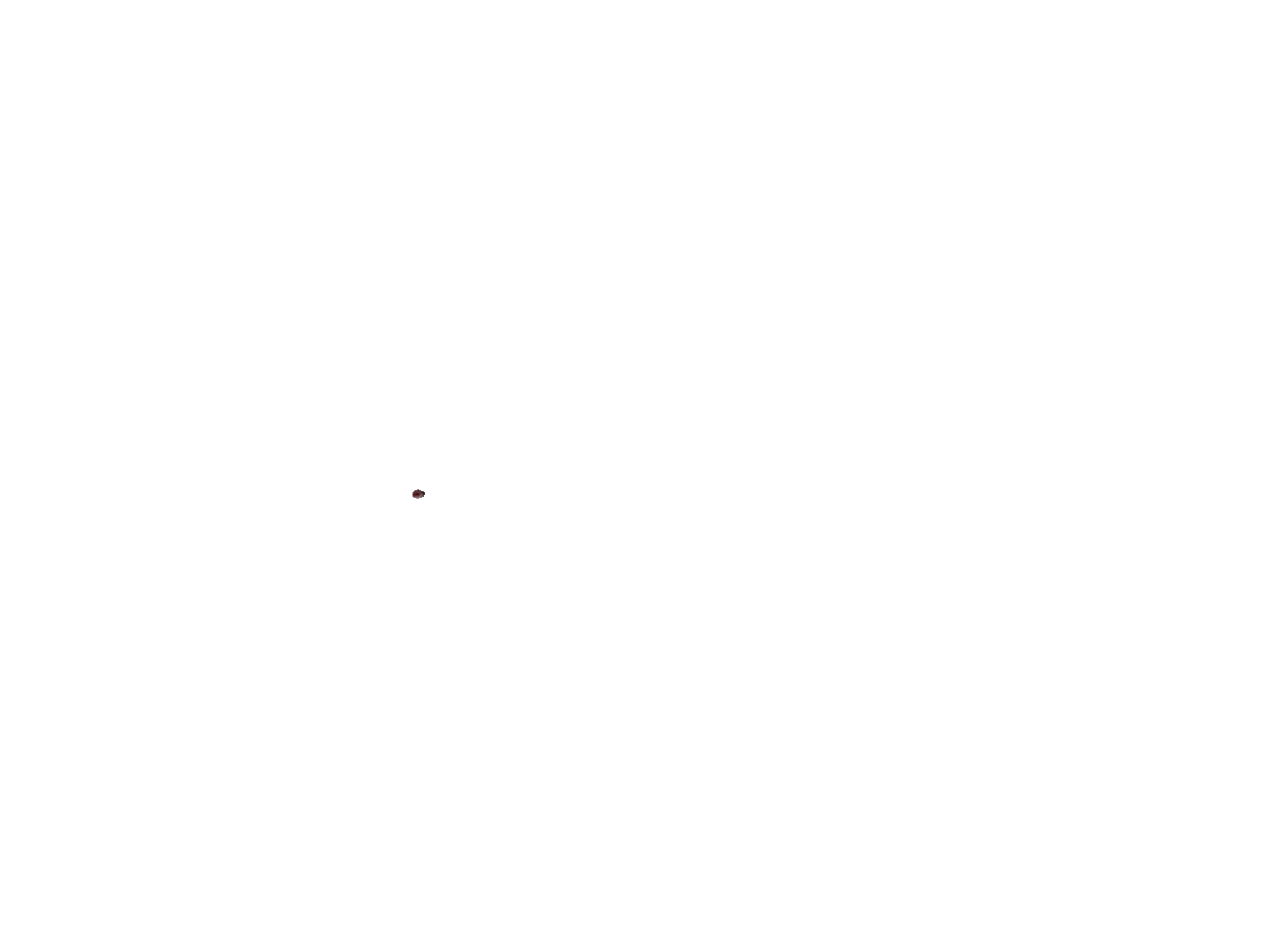semantic-segment-anything
Maintainer: cjwbw

21

| Property | Value |
|---|---|
| Run this model | Run on Replicate |
| API spec | View on Replicate |
| Github link | View on Github |
| Paper link | No paper link provided |
Create account to get full access
Model overview
semantic-segment-anything is an open-source framework developed by researchers at Fudan University that combines the powerful object segmentation capabilities of the Segment Anything Model (SAM) with advanced semantic segmentation models. By integrating these two components, semantic-segment-anything can generate precise object masks with rich semantic annotations, providing a versatile tool for visual understanding tasks.
The framework consists of two main components: the Semantic Segment Anything (SSA) and the Semantic Segment Anything Labeling Engine (SSA-engine). SSA utilizes SAM's generalized object segmentation abilities and combines them with custom semantic segmentation models to predict both accurate object masks and semantic category labels. SSA-engine, on the other hand, is an automated annotation tool that leverages the SSA framework to densely annotate the large-scale SA-1B dataset with open-vocabulary semantic labels, reducing the need for manual labeling.
The semantic-segment-anything model is similar to other AI models like segment-anything-everything, depth-anything, and segment-anything-tryout in its focus on expanding the capabilities of the Segment Anything Model. However, semantic-segment-anything uniquely combines SAM's segmentation prowess with semantic classification, creating a more comprehensive visual understanding system.
Model inputs and outputs
Inputs
- Image: The input image for which semantic segmentation is to be performed.
Outputs
- Semantic segmentation masks: The model outputs a set of segmentation masks, each with a predicted semantic category label.
- Mask metadata: Additional metadata is provided for each mask, including the bounding box, area, segmentation data, predicted IoU, and stability score.
- Semantic category proposals: For each mask, the model provides a top-predicted category label as well as a list of the top-k category proposals.
Capabilities
The semantic-segment-anything framework excels at generating precise object segmentation masks while also providing rich semantic annotations for each detected object. This combination of accurate segmentation and semantic understanding makes it a powerful tool for a variety of visual perception tasks, such as scene understanding, object detection, and image captioning.
The SSA component of the framework can be easily integrated with existing semantic segmentation models, allowing users to leverage the high-quality segmentation abilities of SAM while still utilizing their own specialized classification models. This flexibility and modularity make semantic-segment-anything an attractive solution for researchers and developers working on advanced computer vision applications.
The SSA-engine, on the other hand, demonstrates the potential of the semantic-segment-anything framework to significantly reduce the manual effort required for large-scale dataset annotation. By automatically generating semantic labels for the SA-1B dataset, the SSA-engine lays the groundwork for the development of more robust and comprehensive visual perception models.
What can I use it for?
The semantic-segment-anything framework can be leveraged for a wide range of computer vision applications, including:
- Scene understanding: The rich semantic annotations provided by the model can enhance scene understanding tasks, such as image classification, object detection, and instance segmentation.
- Image captioning and visual question answering: The semantic segmentation outputs can be used as input features for more advanced vision-language models, improving their performance on tasks like image captioning and visual question answering.
- Robotic perception: The precise object segmentation and semantic labeling capabilities of
semantic-segment-anythingcan be valuable for robotic perception tasks, such as object manipulation and navigation. - Dataset annotation: The SSA-engine's automated annotation capabilities can significantly reduce the time and cost associated with labeling large-scale visual datasets, accelerating the development of more advanced computer vision models.
Things to try
One interesting aspect of the semantic-segment-anything framework is its ability to integrate with existing semantic segmentation models. This means that users can leverage the powerful segmentation abilities of SAM while still utilizing their own specialized classification models, allowing for more customized and domain-specific applications.
Another intriguing possibility is to explore the use of semantic-segment-anything in conjunction with other AI models, such as depth-anything or audiosep, to create even more comprehensive visual understanding systems. By combining multiple complementary AI capabilities, researchers and developers can unlock new possibilities for advanced computer vision applications.
Overall, the semantic-segment-anything framework represents an exciting advancement in the field of visual perception, providing a versatile and powerful tool for a wide range of computer vision tasks.
This summary was produced with help from an AI and may contain inaccuracies - check out the links to read the original source documents!
Related Models

anything-v3.0

353
anything-v3.0 is a high-quality, highly detailed anime-style stable diffusion model created by cjwbw. It builds upon similar models like anything-v4.0, anything-v3-better-vae, and eimis_anime_diffusion to provide high-quality, anime-style text-to-image generation. Model Inputs and Outputs anything-v3.0 takes in a text prompt and various settings like seed, image size, and guidance scale to generate detailed, anime-style images. The model outputs an array of image URLs. Inputs Prompt**: The text prompt describing the desired image Seed**: A random seed to ensure consistency across generations Width/Height**: The size of the output image Num Outputs**: The number of images to generate Guidance Scale**: The scale for classifier-free guidance Negative Prompt**: Text describing what should not be present in the generated image Outputs An array of image URLs representing the generated anime-style images Capabilities anything-v3.0 can generate highly detailed, anime-style images from text prompts. It excels at producing visually stunning and cohesive scenes with specific characters, settings, and moods. What Can I Use It For? anything-v3.0 is well-suited for a variety of creative projects, such as generating illustrations, character designs, or concept art for anime, manga, or other media. The model's ability to capture the unique aesthetic of anime can be particularly valuable for artists, designers, and content creators looking to incorporate this style into their work. Things to Try Experiment with different prompts to see the range of anime-style images anything-v3.0 can generate. Try combining the model with other tools or techniques, such as image editing software, to further refine and enhance the output. Additionally, consider exploring the model's capabilities for generating specific character types, settings, or moods to suit your creative needs.
Updated Invalid Date

segment-anything-automatic

3
The segment-anything-automatic model, created by pablodawson, is a version of the Segment Anything Model (SAM) that can automatically generate segmentation masks for all objects in an image. SAM is a powerful AI model developed by Meta AI Research that can produce high-quality object masks from simple input prompts like points or bounding boxes. Similar models include segment-anything-everything and the official segment-anything model. Model inputs and outputs The segment-anything-automatic model takes an image as its input and automatically generates segmentation masks for all objects in the image. The model supports various input parameters to control the mask generation process, such as the resize width, the number of crop layers, the non-maximum suppression thresholds, and more. Inputs image**: The input image to generate segmentation masks for. resize_width**: The width to resize the image to before running inference (default is 1024). crop_n_layers**: The number of layers to run mask prediction on crops of the image (default is 0). box_nms_thresh**: The box IoU cutoff used by non-maximal suppression to filter duplicate masks (default is 0.7). crop_nms_thresh**: The box IoU cutoff used by non-maximal suppression to filter duplicate masks between different crops (default is 0.7). points_per_side**: The number of points to be sampled along one side of the image (default is 32). pred_iou_thresh**: A filtering threshold between 0 and 1 using the model's predicted mask quality (default is 0.88). crop_overlap_ratio**: The degree to which crops overlap (default is 0.3413333333333333). min_mask_region_area**: The minimum area of a mask region to keep after postprocessing (default is 0). stability_score_offset**: The amount to shift the cutoff when calculating the stability score (default is 1). stability_score_thresh**: A filtering threshold between 0 and 1 using the stability of the mask under changes to the cutoff (default is 0.95). crop_n_points_downscale_factor**: The factor to scale down the number of points-per-side sampled in each layer (default is 1). Outputs Output**: A URI to the generated segmentation masks for the input image. Capabilities The segment-anything-automatic model can automatically generate high-quality segmentation masks for all objects in an image, without requiring any manual input prompts. This makes it a powerful tool for tasks like image analysis, object detection, and image editing. The model's strong zero-shot performance allows it to work well on a variety of image types and scenes. What can I use it for? The segment-anything-automatic model can be used for a wide range of applications, including: Image analysis**: Automatically detect and segment all objects in an image for further analysis. Object detection**: Use the generated masks to identify and locate specific objects within an image. Image editing**: Leverage the precise segmentation masks to selectively modify or remove objects in an image. Automation**: Integrate the model into image processing pipelines to automate repetitive segmentation tasks. Things to try Some interesting things to try with the segment-anything-automatic model include: Experiment with the various input parameters to see how they affect the generated masks, and find the optimal settings for your specific use case. Combine the segmentation masks with other computer vision techniques, such as object classification or instance segmentation, to build more advanced image processing applications. Explore using the model for creative applications, such as image compositing or digital artwork, where the precise segmentation capabilities can be valuable. Compare the performance of the segment-anything-automatic model to similar models, such as segment-anything-everything or the official segment-anything model, to find the best fit for your needs.
Updated Invalid Date

segmentanything

1
The segmentanything model, created by maintainer leandroamaral, is a powerful AI model that can segment anything in an image. It is similar to other models like segment-anything-automatic, segment_anything_model, segment-anything-everything, and sam-2, all of which focus on object segmentation in images. Model inputs and outputs The segmentanything model takes in an image and various input parameters to control the segmentation process. These include an IoU (Intersection over Union) threshold for filtering annotations, an object confidence threshold, options for drawing high-resolution masks and contours, and prompts for bounding boxes, text, and points. The model then outputs a URI for the segmented image. Inputs Image**: The input image Iou**: The IoU threshold for filtering annotations Conf**: The object confidence threshold Retina**: Whether to draw high-resolution segmentation masks Box Prompt**: The bounding box prompt in the format [x,y,w,h] Model Name**: The model to use, with the default being FastSAM-x Point Label**: The point label in the format [0] (0 for background, 1 for foreground) Text Prompt**: The text prompt to use, e.g., "a black dog" Point Prompt**: The point prompt in the format [[x1,y1],[x2,y2]] Withcontours**: Whether to draw the edges of the masks Better Quality**: Whether to use better quality segmentation with morphologyEx Outputs Output**: A URI for the segmented image Capabilities The segmentanything model can accurately segment any object in an image, regardless of its size, shape, or location. It can handle a wide variety of objects, from small household items to large animals or buildings. The model's advanced segmentation capabilities make it useful for a range of applications, such as image editing, object detection, and scene understanding. What can I use it for? The segmentanything model can be used in a variety of applications, such as: Image Editing**: Easily remove or isolate objects from images for editing or compositing purposes. Object Detection**: Automatically detect and segment objects of interest in images for further analysis or processing. Scene Understanding**: Gain a deeper understanding of the contents of an image by segmenting and analyzing the various elements within it. Augmented Reality**: Use the model's segmentation capabilities to overlay digital content on real-world objects in AR applications. Things to try One interesting thing to try with the segmentanything model is to experiment with the various input prompts and parameters to see how they affect the segmentation results. For example, you could try using different text prompts or point prompts to see how the model responds. You could also try adjusting the IoU and confidence thresholds to find the right balance between accuracy and speed. Another interesting thing to try is to use the model in combination with other computer vision techniques, such as object detection or semantic segmentation, to create more complex and powerful applications. By integrating the segmentanything model with other AI models, you can unlock new possibilities for image understanding and manipulation.
Updated Invalid Date

segment-anything-everything

67
The segment-anything-everything model, developed by Replicate creator yyjim, is a tryout of Meta's Segment Anything Model (SAM). SAM is a powerful AI model that can produce high-quality object masks from input prompts such as points or boxes, and it can be used to generate masks for all objects in an image. It has been trained on a dataset of 11 million images and 1.1 billion masks, giving it strong zero-shot performance on a variety of segmentation tasks. Similar models include ram-grounded-sam from idea-research, which combines SAM with a strong image tagging model, and the official segment-anything model from ybelkada, which provides detailed instructions on how to download and use the model. Model inputs and outputs The segment-anything-everything model takes an input image and allows you to specify various parameters for mask generation, such as whether to only return the mask (without the original image), the maximum number of masks to return, and different thresholds and settings for the mask prediction and post-processing. Inputs image**: The input image, provided as a URI. mask_only**: A boolean flag to indicate whether to only return the mask (without the original image). mask_limit**: The maximum number of masks to return. If set to -1 or None, all masks will be returned. crop_n_layers**: The number of layers of image crops to run the mask prediction on. Higher values can lead to more accurate masks but take longer to process. box_nms_thresh**: The box IoU cutoff used by non-maximal suppression to filter duplicate masks. crop_nms_thresh**: The box IoU cutoff used by non-maximal suppression to filter duplicate masks between different crops. points_per_side: The number of points to be sampled along one side of the image. The total number of points is points_per_side2. pred_iou_thresh**: A filtering threshold in [0, 1], using the model's predicted mask quality. crop_overlap_ratio**: The degree to which crops overlap, as a fraction of the image length. min_mask_region_area**: The minimum area (in pixels) for disconnected regions and holes in masks to be removed during post-processing. stability_score_offset**: The amount to shift the cutoff when calculating the stability score. stability_score_thresh**: A filtering threshold in [0, 1], using the stability of the mask under changes to the cutoff used to binarize the model's mask predictions. crop_n_points_downscale_factor**: The factor by which the number of points-per-side is scaled down in each subsequent layer of image crops. Outputs An array of URIs representing the generated masks. Capabilities The segment-anything-everything model can generate high-quality segmentation masks for objects in an image, even without explicit labeling or training on the specific objects. It can be used to segment a wide variety of objects, from household items to natural scenes, by providing simple input prompts such as points or bounding boxes. What can I use it for? The segment-anything-everything model can be useful for a variety of computer vision and image processing applications, such as: Object detection and segmentation**: Automatically identify and segment objects of interest in images or videos. Image editing and manipulation**: Easily select and extract specific objects from an image for further editing or compositing. Augmented reality**: Accurately segment objects in real-time for AR applications, such as virtual try-on or object occlusion. Robotics and autonomous systems**: Segment objects in the environment to aid in navigation, object manipulation, and scene understanding. Things to try One interesting thing to try with the segment-anything-everything model is to experiment with the various input parameters, such as the number of image crops, the point sampling density, and the different threshold settings. Adjusting these parameters can help you find the right balance between mask quality, processing time, and the specific needs of your application. Another idea is to try using the model in combination with other computer vision techniques, such as object detection or instance segmentation, to create more sophisticated pipelines for complex image analysis tasks. The model's zero-shot capabilities can be a powerful addition to a wider range of computer vision tools and workflows.
Updated Invalid Date